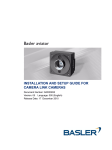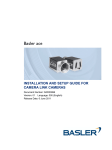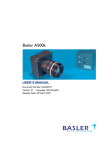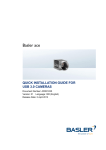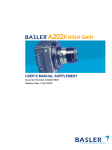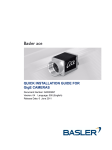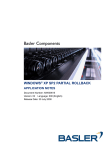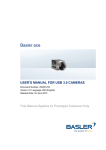Download CCT+ Installation Guide - UCSD Department of Physics
Transcript
Basler Cameras INSTALLATION AND SETUP GUIDE FOR CAMERA LINK CAMERAS Document Number: AW000506 Version: 02 Language: 000 (English) Release Date: 8 September 2010 For customers in the U.S.A. This equipment has been tested and found to comply with the limits for a Class A digital device, pursuant to Part 15 of the FCC Rules. These limits are designed to provide reasonable protection against harmful interference when the equipment is operated in a commercial environment. This equipment generates, uses, and can radiate radio frequency energy and, if not installed and used in accordance with the instruction manual, may cause harmful interference to radio communications. Operation of this equipment in a residential area is likely to cause harmful interference in which case the user will be required to correct the interference at his own expense. You are cautioned that any changes or modifications not expressly approved in this manual could void your authority to operate this equipment. The shielded interface cable recommended in this manual must be used with this equipment in order to comply with the limits for a computing device pursuant to Subpart J of Part 15 of FCC Rules. For customers in Canada This apparatus complies with the Class A limits for radio noise emissions set out in Radio Interference Regulations. Pour utilisateurs au Canada Cet appareil est conforme aux normes Classe A pour bruits radioélectriques, spécifiées dans le Règlement sur le brouillage radioélectrique. Life Support Applications These products are not designed for use in life support appliances, devices, or systems where malfunction of these products can reasonably be expected to result in personal injury. Basler customers using or selling these products for use in such applications do so at their own risk and agree to fully indemnify Basler for any damages resulting from such improper use or sale. Warranty Note Do not open the housing of the camera. The warranty becomes void if the housing is opened. All material in this publication is subject to change without notice and is copyright Basler Vision Technologies. Contacting Basler Support Worldwide Europe: Basler AG An der Strusbek 60 - 62 22926 Ahrensburg Germany Tel.: +49-4102-463-515 Fax.: +49-4102-463-599 [email protected] Americas: Basler, Inc. 855 Springdale Drive, Suite 203 Exton, PA 19341 U.S.A. Tel.: +1-610-280-0171 Fax.: +1-610-280-7608 [email protected] Asia: Basler Asia Pte. Ltd. 8 Boon Lay Way # 03 - 03 Tradehub 21 Singapore 609964 Tel.: +65-6425-0472 Fax.: +65-6425-0473 [email protected] www.baslerweb.com Table of Contents Table of Contents 1 Introduction . . . . . . . . . . . . . . . . . . . . . . . . . . . . . . . . . . . . . . . . . . . . . . . . . . . . . 1 1.1 General Preparations . . . . . . . . . . . . . . . . . . . . . . . . . . . . . . . . . . . . . . . . . . . . . . . . . . . 1 2 Hardware Installation . . . . . . . . . . . . . . . . . . . . . . . . . . . . . . . . . . . . . . . . . . . . . 3 2.1 Precautions. . . . . . . . . . . . . . . . . . . . . . . . . . . . . . . . . . . . . . . . . . . . . . . . . . . . . . . . . . . 3 2.2 Avoiding EMI and ESD Problems . . . . . . . . . . . . . . . . . . . . . . . . . . . . . . . . . . . . . . . . . . 5 2.3 Installation Procedure . . . . . . . . . . . . . . . . . . . . . . . . . . . . . . . . . . . . . . . . . . . . . . . . . . . 6 3 Software Installation . . . . . . . . . . . . . . . . . . . . . . . . . . . . . . . . . . . . . . . . . . . . . . 9 3.1 Basler Camera Configuration Tool Plus (CCT+). . . . . . . . . . . . . . . . . . . . . . . . . . . . . . . 9 3.2 Installing Frame Grabber "Camera Files" . . . . . . . . . . . . . . . . . . . . . . . . . . . . . . . . . . . 14 4 Acquiring Your First Images . . . . . . . . . . . . . . . . . . . . . . . . . . . . . . . . . . . . . . 15 5 Adjusting Image Quality. . . . . . . . . . . . . . . . . . . . . . . . . . . . . . . . . . . . . . . . . . 19 6 Next Steps . . . . . . . . . . . . . . . . . . . . . . . . . . . . . . . . . . . . . . . . . . . . . . . . . . . . . 23 Revision History . . . . . . . . . . . . . . . . . . . . . . . . . . . . . . . . . . . . . . . . . . . . . . . . . . . . . . . . . . . 25 Feedback . . . . . . . . . . . . . . . . . . . . . . . . . . . . . . . . . . . . . . . . . . . . . . . . . . . . . . . . . . . . . . . . . 26 Installation & Setup Guide for Camera Link Cameras i Table of Contents ii Installation & Setup Guide for Camera Link Cameras Introduction 1 Introduction The installation procedure in this guide assumes that you want to get your camera operational and begin capturing images as quickly and as simply as possible. Accordingly, the procedure describes a desktop installation for one camera and assumes that you will be using the Basler Camera Configuration Tool Plus (CCT+) software to set the parameters on your camera. This document applies only to Camera Link®cameras that can be used with the Basler CCT+ software. 1.1 General Preparations Make sure that the following items are available before starting installation: A Basler camera with a Camera Link interface. A suitable power supply for the camera. An appropriate lens. If you already know what lens you will be using in your application, use this lens. Otherwise, we suggest that you use a zoom lens for your initial testing and setup. If you need assistance in determining the best lens for your application, contact Basler technical support. The contact numbers appear in the title pages of this guide. A PC equipped with a Camera Link frame grabber. Depending on you camera model, the frame grabber must support either the base or the medium/full Camera Link configuration. Refer to your camera user’s manual to determine whether your camera uses the base or the medium/full configuration. (As a general rule, base configuration cameras have one 26-pin connector on the back and medium/full cameras have two 26-pin connectors.) The following procedures assume that you have installed a Camera Link frame grabber in your PC, that you have properly installed all software included with the frame grabber, and that you are thoroughly familiar with the operation of your frame grabber. To correctly use your camera, you must also be familiar with the operation of your frame grabber. Installation & Setup Guide for Camera Link Cameras 1 Introduction 2 Installation & Setup Guide for Camera Link Cameras Hardware Installation 2 Hardware Installation 2.1 Precautions NOTICE Prevent damage to the camera. 1. Read the camera User’s Manual and follow its specifications and instructions to prevent damage to the camera. NOTICE Applying incorrect camera power can damage the camera. The camera’s nominal input power voltage is 12 VDC (± 10 %). We do not recommend applying an input voltage less than 10.8 VDC or greater than 13.2 VDC. Applying an input power voltage greater than recommended can seriously damage the camera. Applying power with the wrong polarity can seriously damage the camera. 1. Always make sure that the voltage of the power to the camera is within the specified range. 2. Always make sure that the polarity of the applied voltage is correct. NOTICE Making or breaking connections incorrectly can damage the camera. 1. Be sure that all power to your camera and to your host PC is switched off before you make or break connections to the camera. Making or breaking connections when power is on can result in damage to the camera or to the frame grabber. 2. If you can’t switch off the power, be sure that: a. The input power plug is the last connector that you plug into the camera when making connections. b. The input power plug is the first connector that you unplug from the camera when breaking connections. Installation & Setup Guide for Camera Link Cameras 3 Hardware Installation NOTICE An incorrect plug can damage the 6-pin power connector. 1. The plug on the cable that you attach to the camera’s 6-pin power connector must be a plug for 6 pins. Using a plug designed for a smaller or a larger number of pins can damage the pins in the camera’s 6-pin connector. NOTICE Avoid dust on the sensor. All cameras are shipped with a cap or a self-adhesive protective seal on the lens mount. 1. To avoid collecting dust on the camera’s sensor, make sure that you always put the cap or protective seal in place when there is no lens mounted on the camera. 4 Installation & Setup Guide for Camera Link Cameras Hardware Installation 2.2 Avoiding EMI and ESD Problems The cameras are frequently installed in industrial environments. These environments often include devices that generate electromagnetic interference (EMI) and they are prone to electrostatic discharge (ESD). Excessive EMI and ESD can cause problems with your camera such as false triggering or can cause the camera to suddenly stop capturing images. EMI and ESD can also have a negative impact on the quality of the image data transmitted by the camera. To avoid problems with EMI and ESD, you should follow these general guidelines: Always use high quality shielded cables. The use of high quality cables is one of the best defenses against EMI and ESD. Try to use camera cables that are the correct length and try to run the camera cables parallel to each other. Avoid coiling camera cables. If the cables are too long, use a meandering path rather then coiling the cables. Avoid placing camera cables parallel to wires carrying high-current switching voltages such as wires supplying stepper motors or electrical devices that employ switching technology. Placing camera cables near to these types of devices will cause problems with the camera. Attempt to connect all grounds to a single point, e.g., use a single power outlet for the entire system and connect all grounds to the single outlet. This will help to avoid large ground loops. (Large ground loops can be a primary cause of EMI problems.) Use a line filter on the main power supply. Install the camera and camera cables as far as possible from devices generating sparks. If necessary, use additional shielding. Decrease the risk of electrostatic discharge by taking the following measures: Use conductive materials at the point of installation (e.g., floor, workplace). Use suitable clothing (cotton) and shoes. Control the humidity in your environment. Low humidity can cause ESD problems. The Basler application note called Avoiding EMI and ESD in Basler Camera Installations provides much more detail about avoiding EMI and ESD. The application note can be downloaded at: www.baslerweb.com/indizes/download_index_en_31412.html Installation & Setup Guide for Camera Link Cameras 5 Hardware Installation 2.3 Installation Procedure To install the camera hardware, follow these steps: 1. Make sure that your camera power supply is not connected to the camera and that the power to your host PC is switched off. In the following step, you will be removing the dust cap or self-adhesive protective seal from the camera’s lens mount. To avoid collecting dust or dirt on the imaging sensor, be sure that the lens mount is pointing down when you remove the cap or protective seal. 2. Remove the cap or protective seal from the lens mount on the camera and mount a lens on the camera. 3. Mount the camera in your test setup. 4. If your camera has only one 26-pin MDR connector as shown below: a. Plug one end of a Camera Link cable into the MDR connector on the camera. b. Plug the other end of the Camera Link cable into the connector on your frame grabber that is designated as the base configuration connector. If your camera has two 26-pin MDR connectors as shown below: a. Refer to the Interface chapter in your camera user’s manual and determine which MDR connector on the camera is used for the base Camera Link connection and which MDR connector on the camera is used for the medium/full Camera Link connection. b. Plug one end of a Camera Link cable into the MDR connector on the camera designated for the base Camera Link connection. Plug the other end of the Camera Link cable into the connector on your frame grabber designated as the base configuration connector. c. Plug one end of a Camera Link cable into the MDR connector on the camera designated for the medium/full Camera Link connection. Plug the other end of the Camera Link cable into the connector on your frame grabber designated as the medium/full configuration connector. 6 Installation & Setup Guide for Camera Link Cameras Hardware Installation Typical Camera with One MDR Connector (connector location varies by model) Typical Camera with Two MDR Connectors 26-pin MDR Connector (connector locations vary by model) 5. Make sure that the connectors on the cable(s) are securely fastened to the camera and to the frame grabber. If the connectors are loose, they will cause problems with your images. 6. Switch on the power to your host PC and let the PC boot up. 7. If you obtained the power supply for your camera directly from Basler: a. Connect the plug on the power supply’s output cable to the 6-pin power connector on the camera. b. Plug the power supply into an AC outlet. If you are using a power supply that was not obtained from Basler: a. Refer to the Interface chapter in your camera user’s manual and locate the information regarding the camera input power. Make sure that your power supply can meet the input power requirements. b. In the Interface chapter, locate the information regarding the power connector on your camera. Make sure that the output cable on your power supply is correctly wired and that the cable is terminated with the proper type of plug. If the cable is miswired or the incorrect plug is used, severe damage to the camera can result. c. Connect the plug on the power supply’s output cable to the 6-pin power connector on the camera. d. Plug the power supply into an AC outlet. Hardware installation is complete. Go to the software installation procedure that starts on the next page. Installation & Setup Guide for Camera Link Cameras 7 Hardware Installation 8 Installation & Setup Guide for Camera Link Cameras Software Installation 3 Software Installation 3.1 Basler Camera Configuration Tool Plus (CCT+) The Basler Camera Configuration Tool Plus (CCT+) is a Windows™ based program used to easily change the camera’s settings. The CCT+ is installed on your host PC and uses a serial link that is integrated into the Camera Link interface to communicate with the camera. Two CCT+ installers are available: The 32 bit installer will run on Windows 32 bit and Windows 64 bit operating systems, while the 64 bit installer will only run on Windows 64 bit operating systems. This chapter describes what is required to use the CCT+ software and describes how to install the software. System Requirements To use the CCT+, your computer must meet the following minimum requirements: Windows XP / Vista / Windows 7 Pentium II 233 MHz 128 MB RAM 32 MB free disk space Frame Grabber Serial Port Requirements The CCT+ software resides in your host PC and communicates with the camera via a serial interface that will be a Camera Link serial port or a Windows Com port. For the CCT+ to properly use the serial connection, the frame grabber must provide a software library called clser***.dll (where *** is a unique identifier that varies by manufacturer) to the CCT+. The library provides information that the CCT+ needs to open the serial connection. If you have not already done so, you must install the software that was supplied with your frame grabber now. This will ensure that the required library is available to the CCT+. Note: The CCT+ software requires that the frame grabber clser***.dll is present at a specific location. The location depends on the operating system, on the frame grabber, and on the CCT+ Installation & Setup Guide for Camera Link Cameras 9 Software Installation installer. %SytemRoot% in the following paths stands for the directory of the system where Windows is installed. In the case e.g. of Windows XP this will be C:\Windows For a Windows 32 bit operating system, a frame grabber using a 32 bit clser***.dll, and the CCT+ 32 bit installer: The clser***.dll must be located in %SytemRoot%\system32 For a Windows 64 bit operating system, a frame grabber using a 32 bit clser***.dll, and the CCT+ 32 bit installer: The clser***.dll must be located in %SytemRoot%\SysWOW64 For a Windows 64 bit operating system, a frame grabber using a 64 bit clser***.dll, and the CCT+ 64 bit installer: The clser***.dll must be located in %SytemRoot%\system32 Check the documentation for your frame grabber and make sure that the serial port on the frame grabber has the following settings: 8 data bits, no parity, one stop bit, and baud rate = 9600 bps. Most frame grabbers will provide this as a fixed setup. However, if you are using a grabber on which these settings are definable, check the documentation for the grabber and make sure that the settings are correct. Installing the CCT+ Software 1. If you have an existing version of the CCT+ software installed on your PC, use the Windows Add/Remove programs function and remove it now. 2. A file called SetupCCTPlus_xxxx.exe (where xxxx is the version number of the software) is needed to install the software. If you have not already done so, download the file from the Downloads section of the Basler Components-Machine Vision website at www.baslerweb.com. 3. Open Windows Explorer and Navigate to the directory where you downloaded the file. 4. Double click on the SetupCCTPlus_xxxx.exe file. A self extractor will start and will extract the setup files. When extraction is complete, an installation wizard will start. 5. A Welcome window will open. Click the Next button. 6. A Software License window will open. Accept the agreement and click the Next button. 7. A Customer Information window will open. Enter the appropriate information and click the Next button. 8. A Custom Setup window will open. Click the Next button. (The complete setup will be installed despite the window’s name.) 9. A Ready to Install window will open. Click the Install button. 10. A window displaying the release notes for the software will open. Look through the release notes. When you are finished, click the Next button. 11. An Installation Completed window will open. Click the Finish button. Installation of the CCT+ software is complete. Go to Starting the CCT+ for the First Time on the next page. 10 Installation & Setup Guide for Camera Link Cameras Software Installation Starting the CCT+ for the First Time This procedure assumes that you have properly installed a frame grabber in your PC and that you have performed the hardware installation procedure as described in Section 2 on page 3. 1. Double click the CCT+ icon on your desktop or click Start > All Programs > Basler Vision Technologies > CCT+ > CCT+. 2. The CCT+ program will start. During startup, a splash screen similar to the one shown below will appear. 3. If startup is successful, the CCT+ tool will open and look similar to the illustration below. Because this is the first time that you are starting the tool, no port will be selected. 4. Click the No Port Selected drop down menu. A list of available ports will appear as shown below. Camera Link serial ports that are available via the Camera Link port on your frame grabber can be identified in the list by a name that starts with "clse" plus a port number. Select one of the ports in the list (usually there will only be one port available). Depending on your frame grabber, Windows Com ports may be listed instead or in addition to Camera Link ports, e.g., Com 1 and Com 2. See the documentation of your frame grabber for the availability of ports. If no Camera Link or Windows Com serial port is available, see the troubleshooting tips on Installation & Setup Guide for Camera Link Cameras 11 Software Installation page 13. 5. Once you have selected a port. The configuration tool queries the camera and displays a list of parameter groups similar to the ones shown below. The CCT+ can now be used to set the camera’s parameters. More information about using the CCT+ appears in Chapter 4 of this guide. If you are having trouble connecting the CCT+ software to the camera, see the troubleshooting tips on page 13. 12 Installation & Setup Guide for Camera Link Cameras Software Installation Troubleshooting the CCT+ If the CCT+ immediately closes after startup or if a serial port is not available in the Ports drop down menu, it usually means that there is a conflict with the clser***.dll file (where *** is a unique identifier that varies by manufacturer). To diagnose the conflict: 1. Make sure that you have properly installed the frame grabber software in the correct location on your PC. If you decide to reinstall the software, restart the PC and restart the CCT+ after you complete the reinstallation. 2. Use the CCT+ diagnostic tool if you are still having problems: a. Open Windows Explorer and navigate to C:\Program Files\Basler\CCTPlus. b. Find the file named PortDialog.bat and double click on it. c. A batch program will run, and the Command Prompt window will open briefly and then close. d. A file named PortDiag.log will be generated and placed in C:\Program Files\Basler\CCTPlus. e. Email a copy of the file to Basler technical support. The addresses for technical support are located in the front pages of this manual. The contents of the file will allow technical support to assist you in diagnosing and correcting the problem. Installation & Setup Guide for Camera Link Cameras 13 Software Installation 3.2 Installing Frame Grabber "Camera Files" For your camera to operate correctly with your frame grabber, you must install the correct frame grabber "camera file." In essence, the camera file informs the frame grabber about how the pixel information coming from the camera will be ordered and about the bit depth of the pixel data. Depending on the frame grabber supplier, there can be a separate camera file for each combination of camera model and video data output mode or a camera file may cover several different camera models. Typically, each frame grabber supplier has a different naming scheme for their camera files. For example, Matrox refers to the camera files for their grabbers as "Digital Configuration Files" or DCF files and National Instruments refers to theirs as "Interface Camera Descriptors" or ICD files. Camera files must be supplied by your frame grabber supplier. If you don’t have the camera files for your frame grabber, you can typically find them at the supplier’s web site. Once you have the camera files, there are two things you must keep in mind: First, the camera file that you use must be appropriate for the current video data output mode setting on your camera (refer to your camera User’s Manual for detailed information about available video data output modes). To determine the current video data output mode setting on any Basler Camera Link camera (except A500k models), start the CCT+, expand the Output group or the Output Mode group, and check the setting of the Video Data Output Mode parameter. Note that on A500k and A500kc cameras, the video data output mode on each camera model is fixed. You simply need to get the camera file for your camera model. 14 Second, the camera file must be installed in the correct location on your PC. This location varies depending on your frame grabber supplier. Consult the documentation for your frame grabber to determine where the camera files should be installed. Installation & Setup Guide for Camera Link Cameras Acquiring Your First Images 4 Acquiring Your First Images Before attempting to acquire images, make sure that the camera hardware and software have been installed as described earlier in this guide. To adjust your camera settings, we suggest that you use the Basler Camera Configuration Tool Plus (CCT+) software. The steps below assume that you are using the CCT+. If you want to view the images that you are acquiring, we suggest that you use the software supplied with your frame grabber. Most frame grabbers include software for viewing acquired images. If you have not already done so, you should install this software now, and you should review the instructions for how to use it. The procedure below assumes that you are using your frame grabber’s software to view captured images. Note that when a new camera "wakes up", it will be loaded with a default set of parameters and will be set for "free-run". This means that as soon as you apply power to the camera and the camera finishes booting up, it will begin acquiring images and transmitting pixel data. If you are using software that lets you view captured images, you may start seeing images from the camera as soon as you open the software. At this point, the camera’s parameter settings are preliminary. Information about how to improve your image quality and to make the camera’s basic settings more suitable for your specific application appear later in this guide. To adjust the camera’s settings and acquire images: 1. If you have not already done so, mount the camera in your test setup. The test setup should mimic the way that you intend to use the camera. If you are using a line scan camera, your setup should at least include a provision to continuously move an object through the camera’s field of view. 2. Make sure that your frame grabber has the proper "camera file" installed (see Section 3.2 on page 14). 3. Make sure that the object is properly illuminated. If you need assistance in determining the optimum illumination for your application, contact Basler technical support. The contact numbers appear in the title pages of this manual. Installation & Setup Guide for Camera Link Cameras 15 Acquiring Your First Images 4. To start the CCT+, click the CCT+ icon on your desktop or click Start > All Programs > Basler Vision Technologies > CCT+ > CCT+. The CCT+ will open as shown below. To simplify navigation, camera parameters are organized in related groups. For example, all parameters related to the camera output can be found in the Output group or the Output Mode group (the group name varies for different camera models). When you click on the plus or minus sign beside a group, the parameters in this group will be shown or hidden respectively. Camera parameters names always appear in the left column of the list. The current setting for each parameter appears in the right column. You can display a parameter description window by clicking the Help menu and clicking Parameter Description. The parameter description window provides a short description of the currently selected parameter as shown below. 16 Installation & Setup Guide for Camera Link Cameras Acquiring Your First Images Parameters that can be modified appear in black. Read only parameters and parameters that are currently unavailable appear in gray. To view complete online help, click the Help menu and click Online Help. 5. To get an initial feel for how to adjust your image quality, you will make adjustments to the camera lens and you will also use the CCT+ to make adjustments to the camera’s gain, offset, and exposure time parameter settings. 6. Open the lens aperture "halfway" by choosing an intermediate f-number. 7. Make sure that the camera is set for the Free Run Programmable exposure time control mode: a. Click the + sign next to the Exposure parameters group. The parameters group will expand. b. Click on the Exposure Time Control Mode parameter in the left column. This selects the parameter. Notice that the selected parameter is highlighted in blue as shown below. c. Make sure that Free Run Programmable is selected in the drop down menu in the right column. 8. Make sure that the Gain setting is 0: a. Click the + sign next to the Gain & Offset parameters group. b. Make sure that the setting indicated in the right column is shown as 0. Note that to change the setting for the Gain, you could either use the slider that appears at the bottom of the CCT+ window or you could type a new value directly into the right column. Installation & Setup Guide for Camera Link Cameras 17 Acquiring Your First Images 9. Change the Exposure Time setting to its lowest allowed value: a. Click on the Exposure Time parameter. b. Use the slider to set the Exposure Time to its lowest allowed value. 10. Use the frame grabber program to display your captured images. At this point, the images should be very dark or completely black. Gradually increase the Exposure Time setting so that your image brightness is almost at the desired level. The frame grabber program should be capturing and displaying images continuously, and you should see the effect of your changes almost immediately. Note: Some frame grabbers do not support changing parameters while the grabber is actively capturing images. In this case, you must stop capturing, change the parameter(s), and restart capturing. 11. Adjust the focus ring on the lens so that the image is properly focused. 12. If required, increase the Gain setting slightly to improve the contrast. 13. Adjust the lens aperture to fine tune the overall image brightness. Also take note of the depth of focus in the acquired images. Adjusting the aperture affects the depth of focus. 14. Adjust the Offset setting: a. Click on the Offset parameter. b. Make fine adjustments to the Offset to ensure that detail in the dark parts of the acquired images is still visible. 15. Continue making adjustments to the Exposure Time, Gain, and Offset until you are comfortable with these settings and you have improved your images as much as possible. Now that you have made the basic adjustments to your image quality, go on to the next chapter of this guide. The next chapter provides more detailed information about making adjustments to achieve the best image quality. 18 Installation & Setup Guide for Camera Link Cameras Adjusting Image Quality 5 Adjusting Image Quality In the following descriptions, image quality is discussed in terms of focus, depth of focus, brightness and contrast. You can adjust image quality with regard to these criteria by choosing appropriate settings. However, the "best" image quality will depend on the specific requirements of your application and therefore no generally applicable "best" settings can be recommended. The adjustments will involve the following: adjusting the brightness of the illumination adjusting the focus setting the lens aperture setting the offset setting the exposure time setting the gain using an IR cut filter (color cameras) We recommend carrying out all fine adjustments with the illumination that you will be using in your actual application. You should be aware that your choice of lens is a major factor in determining image quality. Using a high quality lens will give you much better images than using a low quality lens. If you need assistance in determining the best lens for your application, contact Basler technical support. The contact numbers appear in the title pages of this manual. Focus: You will obtain a focused image only if the lens is correctly mounted on the lens adapter of the camera and if the glass surfaces are clean. The object to be imaged must be within the range of focus of the lens. You can obtain a focused image by turning the focal ring on the lens. Depth of Focus: If the objects you want to image are located at different distances from the camera, you must consider depth of focus. The depth of focus must be sufficiently deep to allow all objects to appear focused in the image. You can change the depth of focus by turning the aperture ring on the lens. Closing the lens aperture (turning the aperture ring to higher f-numbers) increases the depth of focus and vice versa. Note that closing the aperture also decreases the amount of light reaching the camera’s sensor and therefore results in a darker image. Installation & Setup Guide for Camera Link Cameras 19 Adjusting Image Quality Brightness: Among the factors determining the brightness of an image are the intensity of the illumination, the setting of the lens aperture, and the settings for exposure time, gain, and offset. We recommend that you choose brightest illumination possible. This will prevent you from needing to operate the camera using extreme settings. Bright illumination is of central importance to achieving good image quality. If illumination of sufficient brightness is not available, you can select a lens that is optimized for light utilization. Opening the lens aperture will allow more light to reach the camera’s sensor and will therefore increase the brightness of the image. Opening the lens aperture can also increase the effects of optical aberrations. This can cause image distortions and the intensity of light to decrease towards the ends of the sensor (vignetting). In addition, the depth of focus decreases. You can increase the brightness of the image by increasing the camera’s exposure time setting. With this method, brightness is increased by increasing the amount of photons collected for pixel readout. Increasing the exposure time setting may decrease the maximum allowed line rate (on line scan cameras) or frame rate (on area scan cameras). Increasing the gain will also increase image brightness. Increasing the gain too much, however, can cause a loss of detail in the brightest portions of the image. Unless your application requires extremely high contrast, you should make sure that detail remains visible in the brightest portions of the image when increasing gain. In the captured images below, notice how brightness increases as the gain increases. Also notice that at very high gain, detail can be lost in the brightest areas of the image. Low Gain 20 Normal Gain Very High Gain Installation & Setup Guide for Camera Link Cameras Adjusting Image Quality You can increase the brightness of the image by increasing the camera’s offset setting. Normally, you should increase the offset setting only as much as is necessary to make detail visible in the darkest portions of an image. Increasing the offset too much may cause a loss of contrast in the image. In the captured images below, notice how brightness increases as the offset increases. Also notice that at very high offset, the overall image loses contrast. Low Offset Normal Offset Very High Offset Exposure Time: The exposure time setting determines the time interval image during which the sensor is exposed to light. Increasing the exposure time is a good way to increase brightness. But keep in mind that increasing exposure time may reduce the camera’s maximum allowed frame acquisition rate (area scan cameras) or line acquisition rate (line scan cameras). Gain: Gain amplifies the values output by the pixels in the camera’s sensor. Increasing gain will increase the image brightness. You can also increase the contrast in the image by increasing the camera’s gain setting. Unless your application requires extreme contrast, make sure that detail remains visible in the brightest portions of the image when increasing gain. Set the gain only as high as is necessary. Because the gain function amplifies the signal and the noise proportionately, increasing the gain does not improve the signal-to-noise ratio. Installation & Setup Guide for Camera Link Cameras 21 Adjusting Image Quality Contrast: Strong contrast in an image is obtained when objects of different brightnesses are represented by very different grey values. For most applications, optimum contrast is achieved when the image displays a wide range of gray values with fine detail remaining visible in the darkest and brightest parts of an image. Some applications, however, may require extreme contrast. You can increase the contrast in the image by increasing the camera’s gain setting. High offset settings will prevent high contrast. Closing the lens aperture not only decreases image brightness but also increases contrast towards the edges of an image. If you must use a low level of illumination and this results in dark images, you may notice the blurring influence of noise. If you operate the camera near the high end of its specified temperature range, the effects may be particularly noticeable. You can increase contrast by lowering the operating temperature of the camera. Since increasing the gain will increase both signal and noise in equal proportion, increasing the gain does not improve the signal-to-noise ratio. IR Cut Filter (color cameras): To obtain proper color reproduction, it is important to use an IR cut filter when working with a color camera. When an IR cut filter is not used, colors will often appear "muddy" or can have the wrong hue. Many Basler color cameras that have a C-mount lens adapter are equipped with an internal IR cut filter. On these cameras, an external filter is not required. If you are using a Basler color camera with a C-mount lens adapter, refer to your camera user’s manual to determine if it is equipped with an internal filter. All Basler color cameras that have an F-mount lens adapter do not include an internal IR cut filter. And some Basler color cameras equipped with a C-mount adapter also do not include an internal filter. If your camera is not equipped with an internal IR cut filter, you should use an external filter with the camera. Refer to your camera user’s manual for more information about the characteristics of the filter you should use. 22 Installation & Setup Guide for Camera Link Cameras Next Steps 6 Next Steps We assume that you have succeeded in acquiring images and setting the camera’s basic parameters using the CCT+ and that you were able to optimize the image quality. To meet the requirements of your application, you will likely need to change additional camera settings and to modify earlier camera settings. Refer to the Operation and Features chapter in your camera user’s manual for details about additional camera settings. Contact Basler technical support if you need further assistance. The contact numbers appear on the title page of this manual. If you have not already done so, implement the typical conditions of operation as required by your application before proceeding with the next steps. In particular, choose the lens and the illumination required by your application. Before making the additional camera settings, you must know the requirements for your application regarding depth of focus, image acquisition rate, size of the AOI, and contrast. And you must know what the priority of the requirements are since some of the settings depend on each other or have opposite effects. On line scan cameras, for example, a high line rate may not be achieveable with the exposure time set to a high value. Your next steps will involve some or all of the following: Selecting the video data output mode (all models except the A500k). Selecting a triggering scheme and an exposure control mode. Fine tuning the exposure time. Defining an AOI. Enabling and parameterizing other features available on your specific camera model. Configuring the camera from within your application program by using binary commands. Installation & Setup Guide for Camera Link Cameras 23 Next Steps 24 Installation & Setup Guide for Camera Link Cameras Revision History Revision History Doc. ID Number Date Changes AW00050601000 20 Nov 2007 Initial release of this document. AW00050602000 8 Sep 2010 Updated the Basler contact information. Added a note about the document applicability in Section 1 on page 1. Added a precaution to read the camera User’s Manual Section 2.1 on page 3. Added a warning not to reverse polarity of the input power in Section 2.1 on page 3. Added a precaution about avoiding dust on the sensor in Section 2.1 on page 3. Expanded Section 2.2 on page 5 about avoiding EMI and ESD problems.. Mentioned a protective seal on the lens mount in Section 2.3 on page 6. Modified Section 3 on page 9 to account for the 32 and 64 bit CCT+ installers. Removed Windows 2000 as compatible operating system in Section 3.1 on page 9. Installation & Setup Guide for Camera Link Cameras 25 Feedback Feedback Your feedback will help us improve our documentation. Please click the link below to access an online feedback form. Your input is greatly appreciated. http://www.baslerweb.com/umfrage/survey.html 26 Installation & Setup Guide for Camera Link Cameras

































